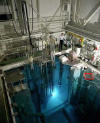Picture Courtesy of http://www.ornl.gov
In the boiling-water reactor, a type of light-water reactor, the water coolant is permitted to boil within the core, by operating at a somewhat lower pressure. The steam produced in the reactor pressure vessel is piped directly to the turbine generator, is condensed, and is then pumped back to the reactor. Although the steam is radioactive, there is no intermediate heat exchanger between the reactor and turbine to decrease efficiency. As in the pressurized-water reactor, the condenser cooling water has a separate source, such as a lake or river. The power level of an operating reactor is monitored by a variety of thermal, flow, and nuclear instruments. Inserting or removing from the core a group of neutron-absorbing control rods controls power output. The position of these rods determines the power level at which the chain reaction is self-sustaining.
Diagram courtesy of
http://www.uic.com
The first large-scale nuclear reactors were built in 1944, at Hanford, Washington, for the production of nuclear weapons material. The fuel was natural uranium metal and the moderator, graphite. Plutonium was produced in these plants by neutron absorption in uranium-238; although power was produced it was not used. A variety of reactor types, characterized by the type of fuel, moderator, and coolant used, have been built throughout the world for the production of electrical power. In the United States, with several exceptions, power reactors use nuclear fuel in the form of uranium oxide, isotopically enriched to about three percent uranium-235. The moderator and coolant are highly purified water. This type of reactor is called a light-water reactor.
In the pressurized-water reactor, a version of the light-water reactor, the water coolant operates at a pressure of about 150 pascals. It is pumped though the reactor core, where it is heated to about 600° K. The superheated water is pumped through a steam generator, where, through heat exchangers, a secondary loop of water is heated and converted to steam. This steam drives one or more turbine generators, where it's heat energy is converted to electrical energy. It is then condensed, and is pumped back to the steam generator. The secondary loop of water is isolated from the water in the reactor core and, therefore, is not radioactive. A third stream of water from a lake, river, or cooling tower is used to condense the steam. A typical reactor pressure vessel is about 22m high and 5m in diameter, with walls 25cm. thick. The core houses some 82 metric tons of uranium oxide, contained in thin corrosion-resistant tubes, clustered into fuel bundles.

